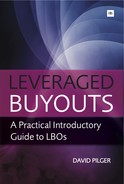Chapter 10: Ebitda
Earnings Before Interest, Taxes, and Depreciation and Amortization is a mouthful. The finance community has naturally enough, therefore, grown accustomed to using the acronym EBITDA. To calculate EBITDA you start with net income and simply add back any interest, taxes, and depreciation and amortization expenses.
It’s worth noting that EBITDA will not appear in any accountant review of a company. This is because EBITDA is not an accounting metric. Rather, it is a means of measuring a company’s profitability. What is, perhaps, most significant about EBITDA is that it enables the comparison of profitability between companies regardless of capital structure and accounting treatment.
We can calculate EBITDA by first turning our attention to Year 0, cell (E49). As mentioned, EBITDA can be calculated a number of ways. It is essentially,
net income + net interest expense + tax expense + depreciation and amortization expense
Remember that in our example we represent expenses as negative numbers. For that reason, we will need to subtract the negative expense numbers to arrive at EBITDA. We begin in cell (E49) and set our formula to equal
net income (E47) - (negative) tax expense (E46) - (negative) interest expense - interest income - (negative) depreciation and amortization expense
This may seem counterintuitive at first, but developing a method to easily distinguish between positive income flows versus negative expense flows will help you and the beneficiaries of your analysis keep matters straight when reviewing financial analysis. However, formatting is a matter of subjective taste and you are encouraged to adhere to the taste of the person paying your salary!
Another way that you could have calculated EBITDA based on our example is to set the EBITDA (E49) formula equal to operating income (E42) plus depreciation and amortization expense (E54). This formula would work in our example because only net interest expense and tax expense stand between net income and operating income. This method would have saved you a few key strokes in the process of creating your EBITDA formula, but for the purposes of this book we chose to use the more detailed formula. Either formula will bring you to the correct figure on our example.
As we mentioned, EBITDA is a powerful tool for measuring profitability across different companies, while taking out considerations such as the amount and cost of debt on the balance sheet as well as tax treatment. The first cousin of EBITDA, in the family of financial metrics, is EBITDA margin. Like EBITDA, EBITDA margin is also an effective tool in measuring the profitability of a company. However, EBITDA margin is unique to EBITDA in that it is not concerned with the absolute size of business operations; instead it measures how adequate a company is at generating earnings (before interest, taxes, depreciation and amortization) relative to every dollar of revenue that is brought in. It is a good indicator of efficiency and a company’s ability to drive profits from its revenues.
“EBITDA is a powerful tool for measuring profitability across different companies.”
Calculating both EBITDA and EBITDA margin together provides a more complete analysis when comparing companies. While every company would like to have a relatively large EBITDA margin to report at the end of each fiscal year, it means very little if net revenues were down 90% from the previous year. Likewise, a relatively large EBITDA figure is always more desirable than a small one, but few executives would be bragging if EBITDA for the year end increased by $1 million while net revenues for the year increased by $100 million. The operating efficiency of the company, in this hypothetical case, went down the tubes. While EBITDA may have increased by $1 million for the year, the executive would most likely be looking for another job in the near future because of the poor operating efficiency of the company, as measured by the decline in EBITDA margin. In summary, both EBITDA and EBITDA margin are potent measures of profitability that level the playing field regarding capital structure and tax treatment. However, they should be calculated together in order to provide a more complete picture of a company’s profitability on both an absolute and relative basis.
Up to this point, you have completed the entire Year 0 column in the income statement for all the items that we are able to address at this time. The only line items that should still remain unaddressed in Year 0 of your income statement are interest income and interest expense. Since we have completed all other aspects of the income statement and because we are not ready to address net interest expense yet, we can now complete years one through five in the explicit forecast range of your income statement. You can do this the same way you filled out the remaining years of the operating section of the income statement a few steps back. Congratulations on completing over 90% of the income statement.
Try using the keyboard shortcut that we demonstrated earlier by starting in cell (E45) and using the SHIFT key and ARROW keys to highlight the area from (E45) through (J50). This covers the area from pre-tax income in Year 0 to EBITDA margin in pro forma Year 5. Once this area is highlighted, press CTRL+R. The remainder of your income statement for the pro forma years one through five should fully populate and transfer each row’s corresponding formulas accordingly.
